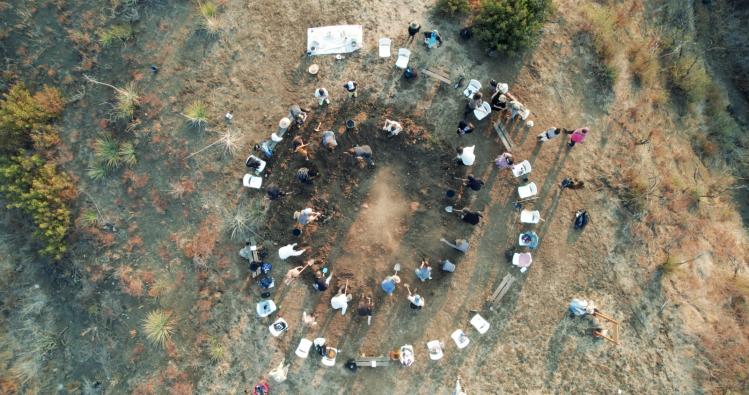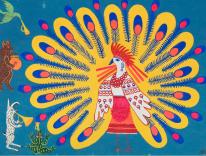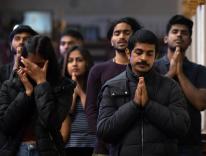
Last year, I attended two funerals: one for a family member, another for the family member of a close friend. Guests coughed and cried. We looked at photographs and listened to speeches. Afterwards, we told stories and splashed water on our faces at bathroom sinks. We were together in our grief.
But also, we were not. I was not having the same experience as other relatives of the deceased: his sister, or his college roommate, or her childhood playmate, or even her other grand-niece. Each was thinking of traits that had existed only in their presence, a style of humor or cadence. Each was running through memories only they had managed to store, although others in the room might have been there, too. “I don’t remember that.” “Really? When did that happen?”
Grief is lonely. Every instance can feel so unique as to be untranslatable, and in our desperation to be understood, we often fall back on clichés. We talk of the five stages; we describe emptiness and numbness; we say “sorry for your loss.” And still, nobody understands. Maybe the solution is to give up on language and create something physical instead: a common reference point that allows each mourner to cast their own interpretations, to share something without having to articulate anything.
That’s one premise at the heart of To Survive I Need You to Survive, an exhibition by sculptor and “social practice artist” Cara Levine currently on display at the Contemporary Jewish Museum in San Francisco. Visualized, quantified expressions of grief, read the show notes, might “offer opportunities for interconnectedness rather than isolation.”
“Grief to Fill a Room With” is one such visual expression, a scene staged in a section of the white-walled gallery. Everyday objects—a table, chairs, pants hanging in an armoire, a fiddle-leaf fig plant dropping its discolored leaves—are pushed against the edges of the gallery walls and floor by an inflated plastic dome. In this rendering, grief is odorless, colorless, filling an entire room, imperceptible to anyone but the bereaved. I’ve felt that, exactly, I thought, standing outside the bubble. By rendering isolation, Levine made me less isolated.
The same principle—communion through art—underlies the exhibit’s two performance pieces. In “DIG: A Hole to Put Your Grief In,” a group gathers in the Santa Monica Mountains to dig a hole; participants then refill it over a period of seven days. A video documents the process: shovels striking dirt, workers pouring water over their dusty hands, the sky changing colors. This project has concluded, but another one, “Carve; The Mystic is Nourished From This Sphere,” is ongoing. Museum-goers are provided pencils and paper and asked to deposit their responses to the prompt “Today, I’m grieving…” in a box nearby. Levine then carves the submissions into a concave wooden structure mounted on the wall. When I visited, some inscriptions had already been made: “Two sons I lost.” “Dad’s voice.”
Both of these works are acts of ritual, “DIG” explicitly so. Taking place over seven days to represent sitting shiva, it incorporates bundles of sage, a service from a cantor, and a ceremony by a Chumash tribal leader; the artist wears all white as she reads the words of Kabbalist rabbi Moses de León. “Carve” takes the latter part of its title from the description of chokmah (wisdom) found in the Zohar, a sacred Kabbalah text that de León is believed to have authored. In the repetitive motions of shoveling and carving, “DIG” and “Carve” excavate literal spaces for grief.
But in both instances, the power of these symbols is diminished by language. An eleven-minute documentary film recounting the making of “DIG” features not just haunting aerial shots of turned-over earth, but reflections from the diggers themselves, many of whom are artists. They use words like “systemic” and “parse” and “energy.” They are grieving the pandemic and violence against migrants and environmental devastation.
It’s not that these aren’t worthy griefs; of course they are. But stating them out loud over-interprets the hole in the ground, makes it an intellectual statement rather than a visceral experience. Any viewer might have read these tragedies into the piece implicitly; the explanations aren’t necessary. As it is, “DIG” is mediated by others’ words before we have a chance to interpret it ourselves.
The same is true of “Carve.” Scratching down my entry and slipping it into the box, I thought about which formulation the artist would be most likely to choose when she returned to her ladder and chisels. So far, she’d selected for timeliness (“Monterey Park, Lunar New Year”) and referentiality (“dancing in crowded spaces”) and variety (“fat orange cat”). Other entries were visible through the clear walls of the box. “Innocence” and “the road not taken” were good candidates, I thought; they’d work well on the wall. But that was precisely the problem. In writing for an audience, at least some of us were editing in the hope of inclusion. Gashes in the wood, one gouged tally for every sorrow, might have conveyed our pain better than words ever could.
“To survive I need you to survive,” reads the text that lends its name to the exhibit. Carved in capital letters along the circumference of a birch-and-oak wheel, they run together like a mantra: TO SURVIVE I NEED YOU TO SURVIVE TO SURVIVE I NEED YOU TO SURVIVE. A timelapse video shows the wheel positioned on a roof. Over the course of a day, light runs through it, casting shadows on the ground. From sunrise to sunset, its message holds true.
Levine adapted the phrase from a gospel song she heard at an interfaith service in the aftermath of the 2018 shooting at Pittsburgh’s Tree of Life Synagogue. It’s an expression of mutual dependency, total solidarity, the ethic at the heart of her faith tradition and mine.
But the exhibit’s most powerful work, “This Is Not A Gun,” demonstrates how challenging that solidarity can be. Working from a list of things mistaken for guns during shootings of civilians (many of them Black men) by police, Levine has carved a pill bottle and a hairbrush and sunglasses from wood. In workshops, she invited others to submit their renderings of items from the list in clay. The resulting objects fill a platform in the center of the gallery, a collection of sandwiches (some with tomato, some with seeded bread) and beer bottles (one etched with “Corona”) and candy bars (various interpretations of Skittles and Snickers) and phones (smart, flip) and Bibles (large, pocket-sized, English, Spanish). The objects are profound in their everydayness.
This portion of the exhibit contains supplementary educational materials—copies of Caste and Just Mercy (meant to be read while in the gallery?) and “workshop ephemera,” note cards with questions like “What effect does the criminalization of people of color have on society?” tacked to the walls. The materials feel redundant; nothing is so powerful as the display itself. And for all of its encouragement toward advocacy, the work asserts another truth, too: You can’t understand.
In my hands, a sandwich, or a bottle of cologne, even a gun-shaped object like a hose nozzle or a drill, is perfectly safe. In other hands, not so much. Levine lists the time it took her to carve each sculpture, hours in comparison to the split seconds in which an officer made a judgment. There’s a fundamental disconnect, for her and for me, and for many others who will see the exhibit. We can empathize, but we can’t entirely understand. We can acknowledge that we’re essential to each other’s survival while also recognizing that for some of us, it’s easier to stay alive.
In grief, as in love and joy and anger, particularity always persists. The paper replications Levine makes of two objects inherited from her now-dead grandmothers—an amber pendant necklace containing the first line of the Shema (“Hear, O Israel, the Lord your God is one…”) and a watercolor painting of the Hebrew letter kaf—demonstrate just how insular our sorrow can be. It’s a small, private, humble act, to make copies of two treasured objects only because you loved their owners. It’s also a kind of prayer, directed to the One who alone knows the fullness of our grief. The best kind of ritual attempts not to explain our sadness but to retain its fundamental mystery, trusting that God can elucidate the rest. We sit side by side in the funeral hall, together and also alone, beside and also before.
Please email comments to [email protected] and join the conversation on our Facebook page.
Previous Story
Anti-Semitism & the Catholic Church
Next Story
Learning the Wrong Lessons from Ukraine

